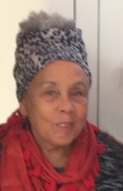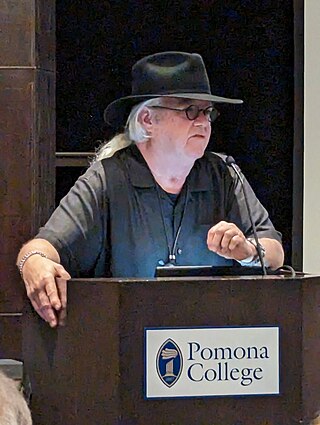
Betye Irene Saar is an African American artist known for her work in the medium of assemblage. Saar is a visual storyteller and an accomplished printmaker. Saar was a part of the Black Arts Movement in the 1970s, which engaged myths and stereotypes about race and femininity. Her work is considered highly political, as she challenged negative ideas about African Americans throughout her career; Saar is best known for her artwork that critiques American racism toward Black people.

Peter Shelton is a contemporary American sculptor born in 1951 in Troy, Ohio.
Craft Contemporary, formerly the Craft and Folk Art Museum, is a non-profit, non-collecting arts museum dedicated to showcasing contemporary craft in Los Angeles, California. The museum is located on Los Angeles' Museum Row on Wilshire Boulevard, and across from the George C. Page Museum and La Brea Tar Pits. It is the only institution on the West Coast of the United States to focus exclusively on craft.
Meg Linton is an American curator of contemporary art and a writer. Her curatorial efforts have ranged from historical investigations such as "Doin’ It in Public: Feminism and Art at the Woman’s Building", "The Los Angeles School: Karl Benjamin, Lorser Feitelson, Frederick Hammersley, June Harwood, Helen Lundeberg, John McLaughlin", and "In the Land of Retinal Delights: The Juxtapoz Factor" to showcasing the work of single artists who are stylistically different such as "Alison Saar: STILL.. .", "Robert Williams: Through Prehensile Eye," and "Joan Tanner: On Tenderhook" to group exhibitions such as "Mexicali Biennial 2010," "Do It Now: Live Green!" and "Tapping the Third Realm."
"Where We At" Black Women Artists, Inc. (WWA) was a collective of Black women artists affiliated with the Black Arts Movement of the 1960s and 1970s. It included artists such as Dindga McCannon, Kay Brown, Faith Ringgold, Carol Blank, Jerri Crooks, Charlotte Kâ (Richardson), and Gylbert Coker. Where We At was formed in the spring of 1971, in the wake of an exhibition of the same name organized by 14 Black women artists at the Acts of Art Gallery in Greenwich Village. Themes such as the unity of the Black family, Black female independence and embodiment, Black male-female relationships, contemporary social conditions, and African traditions were central to the work of the WWA artists. The group was intended to serve as a source of empowerment for African-American women, providing a means for them to control their self-representation and to explore issues of Black women's sensibility and aesthetics. Like AfriCobra, a Chicago-based Black Arts group, the WWA was active in fostering art within the African-American community and used it as a tool of awareness and liberation. The group organized workshops in schools, jails and prisons, hospitals, and cultural centers, as well as art classes for youth in their communities.

Maren Hassinger is an African-American artist and educator whose career spans four decades. Hassinger uses sculpture, film, dance, performance art, and public art to explore the relationship between the natural world and industrial materials. She incorporates everyday materials in her art, like wire rope, plastic bags, branches, dirt, newspaper, garbage, leaves, and cardboard boxes. Hassinger has stated that her work “focuses on elements, or even problems—social and environmental—that we all share, and in which we all have a stake…. I want it to be a humane and humanistic statement about our future together.”

Sabina Ott was an American artist known for her broad range of work—from painting to installation to sculpture—and her central role in the art world as teacher, administrator, and recently, as the founder of the exhibition space Terrain, which invites artists to create installations and performances using the exterior of her Oak Park home.

George Herms is an American artist best known for creating assemblages out of discarded, often rusty, dirty or broken every-day objects, and juxtaposing those objects so as to infuse them with poetry, humor and meaning. He is also known for his works on paper, including works with ink, collage, drawing, paint and poetry. The prolific Herms has also created theater pieces, about which he has said, "I treat it as a Joseph Cornell box big enough that you can walk around in. It's just a continuation of my sculpture, one year at a time." Legendary curator Walter Hopps, who met Herms in 1956, "placed Herms on a dazzling continuum of assemblage artists that includes Pablo Picasso, Kurt Schwitters, Marcel Duchamp, and Joseph Cornell, as well as California luminaries Wallace Berman and Edward Kienholz." Often called a member of the West Coast Beat movement, Herms said that Wallace Berman taught him that "any object, even a mundane cast-off, could be of great interest if contextualized properly." "That’s my whole thing," Herms says. "I turn shit into gold. I just really want to see something I've never seen before." George Herms lives and works in Los Angeles.

Patricia Anne Smith, known professionally as Alexis Smith, was an American visual artist. She worked in collage and installation.
Lisa Lapinski is an American visual artist who creates dense, formally complex sculptures which utilize both the language of traditional craft and advanced semiotics. Her uncanny objects interrogate the production of desire and the exchange of meaning in an image-based society. Discussing a group show in 2007, New York Times Art Writer Holland Cotter noted, "An installation by Lisa Lapinski carries a hefty theory- studies title: 'Christmas Tea-Meeting, Presented by Dialogue and Humanism, Formerly Dialectics and Humanism.' But the piece itself just looks breezily enigmatic." It is often remarked that viewers of Lapinski's sculptures are enticed into an elaborate set of ritualistic decodings. In a review of her work published in ArtForum, Michael Ned Holte noted, "At such moments, it becomes clear that Lapinski's entire systemic logic is less circular than accumulative: What at first seems hermetically sealed is often surprisingly generous upon sustained investigation." Lapinski's work has been exhibited widely in the US and Europe, and she was included in the 2006 Whitney Biennial.
Liz Craft is a Los Angeles installation artist and sculptor. She co-runs the Paradise Garage in Venice Beach, California. Her artwork has been exhibited internationally and collected by museums including the Los Angeles County Museum of Art, LACMA, and the Hammer Museum in Los Angeles.

Coleen Sterritt is an American sculptor known for abstracted, hybrid works made from a myriad of everyday objects and materials, combined in unexpected ways. Writers root her work in the tradition of post-minimalists Jackie Winsor, Eva Hesse and Nancy Graves, and assemblage artists such as Louise Nevelson, Robert Rauschenberg and Marisa Merz; she is sometimes associated with contemporaries Jessica Stockholder, Nancy Rubins, and Tony Cragg. Sculpture critic Kay Whitney suggests Sterritt's work "expands and reinterprets three of the most important artistic inventions of the 20th Century—collage, abstraction and the readymade"— in play with the traditions of Arte Povera bricolage and Surrealist psychological displacement. Curator Andi Campognone considers Sterritt one of the most influential post-1970s artists in establishing "the Los Angeles aesthetic" in contemporary sculpture, while others identify her as an inspiration for later West Coast artists creating hand-made, free-standing sculpture counter to trends toward interventions, public art and environmental works. Constance Mallinson writes that Sterritt's work "walks a line between charm and threat, the natural, the industrial and the hand fabricated, rejecting easy associations for complex reads." Los Angeles Times critic David Pagel calls it smart, funky and "subtly rebellious" in its refashioning of discarded material, dumpster finds, and art-historical lineages.
Eileen Abdulrashid is an American artist and craftsperson who is known for her work in enamel on copper.
Hannah Greely is an American mixed media artist. She mainly creates site-specific sculptural works that seek to redefine the boundary between art and life. Her sculptures are colorful and often replicate ordinary objects or subjects, with subtle incongruencies in material or form. Her material experimentations lend the work an uncanny quality, as recognizable objects fade from real to fictional. Greely’s work explores open dialogue between object and environment, as well as the theatrical otherness of sculpture.
Sue Williams is an American artist born in 1954. She came to prominence in the early 1980s, with works that echoed and argued with the dominant postmodern feminist aesthetic of the time. In the years since, her focus has never waned yet her aesthetic interests have moved toward abstraction along with her subject matter and memories. She lives and works in New York.

Lezley Irene Saar is an African American artist whose artwork is responsive to race, gender, female identity, and her ancestral history. Her works are primarily mixed media, 3-dimensional, and oil & acrylic on paper and canvas. Through her artistic practice Lezley explores western and non-western concepts of beauty, feminist psychology and spirituality. Many works conjure elements of magical realism. She has exhibited widely in the U.S. and internationally. Her work is included in museum collections such as The Kemper Museum, CAAM, The Ackland Art Museum, the Smith College Museum of Art, the Studio Museum in Harlem and MOCA. She is currently represented by Walter Maciel Gallery in Los Angeles and Various Small Fires in Asia.
Tomashi Jackson is an American multimedia artist working across painting, video, textiles and sculpture. Jackson was born in Houston, Texas, raised in Los Angeles, and currently lives and works in New York, NY and Cambridge, MA. Jackson was named a 2019 Whitney Biennial participating artist. Jackson also serves on the faculty for sculpture at Rhode Island School of Design. Her work is included in the collection of MOCA Los Angeles. In 2004, a 20-foot-high by 80-foot-long mural by Jackson entitled Evolution of a Community was unveiled in the Los Angeles neighborhood of West Adams.

Gloria Kisch (1941–2014) was an American artist and sculptor known especially for her early post-Minimalist paintings and wall sculptures, and her later large-scale work in metal.
Gloria Racine Bohanon was an American visual artist and educator based in Los Angeles, California. She was born in Atlanta, Georgia. She received a BA in Art Education and an MA in Art Education from Wayne State. She also studied at Otis College of Art and Design in 1973. She was an active member of the Los Angeles contemporary art scene in the 1970s. As a professor at Los Angeles Community College, she organized "Black Culture Week" in 1974. She taught design, painting, printmaking, and served as chair of the Arts Department while there. She was the director of ADAPT, an organization for disabled students while at LACC.
Yvonne Olivia Cole Meo (1923–2016) was an American artist known primarily for sculpture and printmaking. Born in Seattle, Washington, Meo lived in Los Angeles for most of her life, primarily in Altadena CA.












